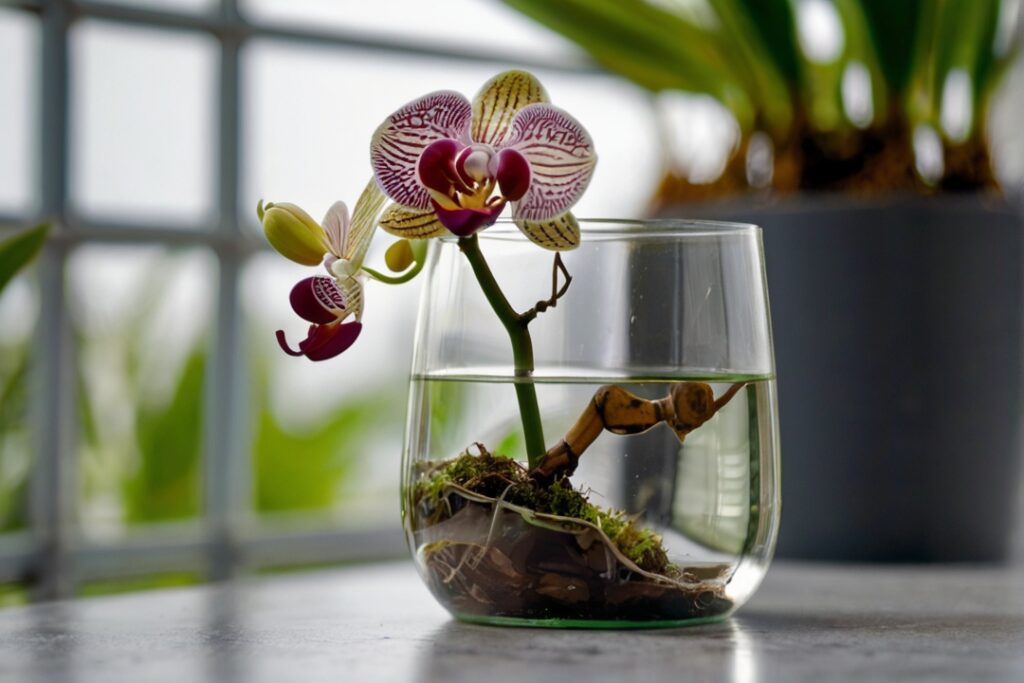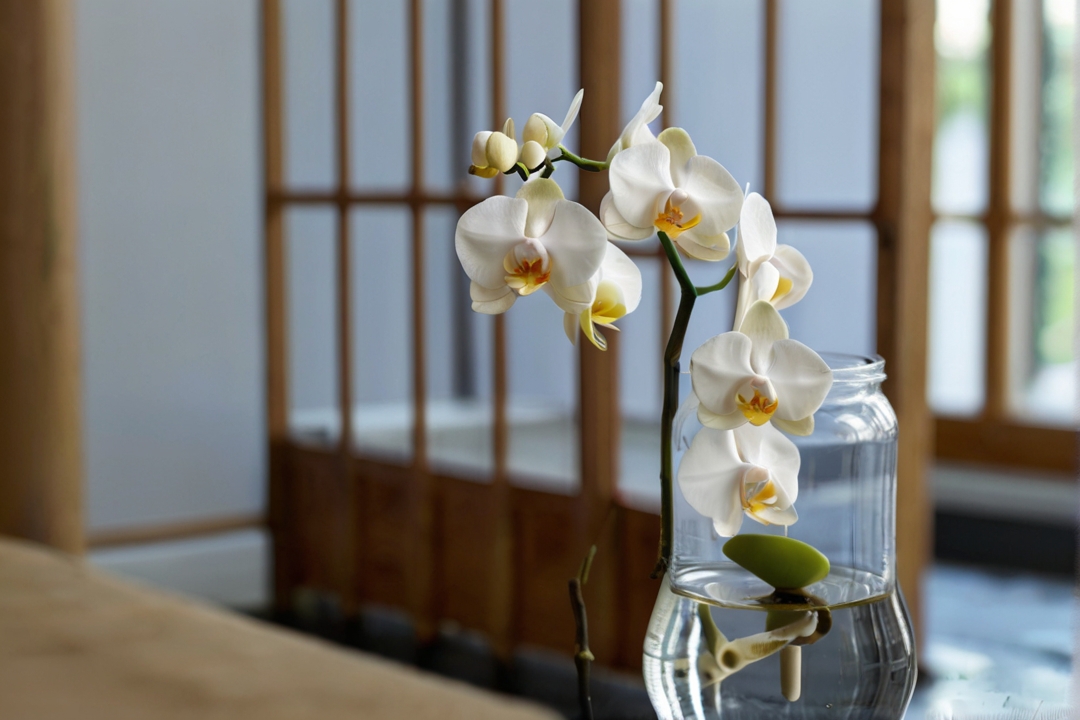Hydroponic gardening offers an innovative approach to growing plants without soil, and it’s surprisingly well-suited for the delicate beauty of orchids. If you’re looking for a rewarding and water-efficient way to cultivate these exotic flowers, the hydroponic method could be just the thing.
This guide is crafted to walk you through developing orchids in a hydroponic setup, whether you’re a gardening enthusiast, hydroponic beginner, or dedicated orchid lover.
Table of Contents
- Why Use Water Culture For Orchids?
- Getting Started with Hydroponic Orchids
- Semi Vs Full Water Culture for Orchids
- Planting and Caring for Orchids in Water Culture
- Growing Orchids in Water Culture with Kelp
- Maintenance and Troubleshooting for Hydroponic Orchids
- Harvesting and Enjoying Your Hydroponic Orchids
- Conclusion
Why Use Water Culture For Orchids?

Using water culture for orchids has become increasingly popular among gardeners and plant enthusiasts.
Water Efficiency
Hydroponic gardening is known for its efficient use of water culture. In traditional soil-based gardening, much water goes unused as it drains through the soil and out of the pot. With hydroponics, all the water is contained in the system and is continuously recirculated, resulting in less water waste.
Nutrient Control
In hydroponics, water delivers the nutrients directly to the plant’s roots. This allows for precise control over what nutrients and how much of them the plants receive. Orchids require specific nutrients at different growth stages, making this control level essential for their health and development.
Disease Prevention
Soil can be a breeding ground for diseases and pests that can harm orchids. Using water culture for orchids eliminates the risk of soil-borne diseases. This makes hydroponic orchids less susceptible to common plant problems, resulting in stronger and healthier plants.
Busy Schedule Friendly
Hydroponic systems require less maintenance compared to traditional soil-based gardening, making them ideal for those with a busy schedule. Once the system is set up, you can relax and let it do its thing.
Getting Started with Hydroponic Orchids

When transitioning your orchids to a hydroponic environment, there are a few crucial factors to consider. First, you’ll need to select orchid species that thrive in water culture. Next, carefully choose a suitable container and mix a nutrient solution that meets their needs.
1. Selecting the Right Orchid Species
Not all orchids are created equal when it comes to hydroponics. Terrestrial orchids, accustomed to more organic substrates, may not fare well.
On the other hand, Epiphytic orchids such as Phalaenopsis, Dendrobium, Cattleya, Oncidium, Vanda etc. are used to growing on trees with minimal soil contact and often adapt beautifully to a hydroponic system. The Phalaenopsis and Dendrobium orchid genera are excellent for beginners due to their adaptability.
2. Choosing a Suitable Container
Opt for a transparent container to allow light to reach the roots and make it easier to monitor their health. The container should be wide enough to provide stability, with ample space to allow the roots to spread and air to circulate. Remember that larger containers hold more water, providing a buffer for slight fluctuations in the nutrient solution.
3. Preparing the Hydroponic Solution
Creating the correct nutrient solution is the key to growing orchids in water. Aim for a balance of nutrients tailored to the needs of your orchid species—commercially available hydroponic fertilizer mixes are a great starting point. Keeping pH and nutrient levels within the optimal range is vital, usually slightly acidic with an Electrical Conductivity (EC) of 1.5-2.5 mS/cm for most orchids.
Semi Vs Full Water Culture for Orchids
There are two main types of water culture used for growing orchids: semi water culture and full water culture. Each has its own set of practices, benefits, and considerations.
Semi Water Culture
Semi water culture (SWC) involves a cyclical process of submerging orchid roots in water for a certain period, followed by a drying phase. This method mimics the natural wet-dry cycle that many orchids experience in their native habitats.
How it Works:
- Wet Phase: Orchid roots are submerged in water for 2-3 days. During this time, the roots absorb water and nutrients.
- Dry Phase: The water is then drained, and the roots are allowed to dry out completely for about 4-5 days. This drying period is crucial for preventing root rot and for encouraging healthy root growth.
Benefits:
- Mimics natural environmental conditions.
- Reduces the risk of fungal and bacterial infections due to the drying phase.
- Encourages stronger root systems.
Full Water Culture
Full water culture (FWC) involves keeping orchid roots submerged in water almost constantly, with only occasional changes of water.
How it Works:
- The roots are kept in water continuously, with water changes typically done weekly or bi-weekly to refresh nutrients and oxygen levels and to prevent stagnation.
- Some growers opt to include a brief drying period (a few hours to a day) during water changes to mimic natural conditions slightly and to further discourage rot.
Benefits:
- Simplicity and low maintenance, as there’s no need for regular watering schedules.
- Potentially faster growth due to constant access to water and nutrients.
- Can be a cleaner alternative to soil-based methods.
Planting and Caring for Orchids in Water Culture
With your orchids selected and your equipment ready, it’s time to get them settled into their new hydroponic home and ensure their ongoing care.
1. Transplanting Orchids into the Hydroponic System
To start the process, carefully rinse the roots of your orchid under running water, ensuring all traces of its previous growing medium are removed. Place the orchid into the container, strategically positioning the roots to optimize contact with the nutrient solution for better absorption. It’s crucial to maintain the plant’s crown (the area where the leaves sprout) above the waterline to prevent any potential rot issues from developing.
2. Monitoring Water Levels and Nutrient Solutions
Regularly check that the roots have consistent access to water by ensuring the roots are slightly damp but not soggy. Adjust the water level as needed to maintain optimal moisture. It’s essential to replace the nutrient solution every two weeks to provide fresh nutrients for the growth of the orchid. In between replacements, top up the solution with water to compensate for evaporation or uptake by the plant. This careful maintenance will help your orchid thrive and bloom beautifully.
3. Providing Adequate Light and Temperature
Place your hydroponic orchids in a location with moderate to bright light, ensuring they receive adequate sunlight without exposure to direct sunlight that might cause the water to overheat. Orchids typically thrive in temperatures ranging from 60-80°F (15-27°C) during the day, and it is beneficial to provide a slightly more relaxed environment at night to promote their optimal growth. Remember to monitor the light exposure and temperature levels consistently for the well-being of your orchids.
Growing Orchids in Water Culture with Kelp
Kelp is a natural plant growth promoter and can benefit your hydroponic orchids. It contains essential nutrients, hormones, and enzymes that enhance plants’ health, resistance, and productivity. Kelp also stimulates root development by encouraging beneficial microbial activity in the growing medium, increasing nutrient uptake. Incorporating kelp into your hydroponic system can improve root growth, create healthier foliage, and promote more prolific flowering for your orchid. Follow the instructions on the kelp product carefully for best results.
Maintenance and Troubleshooting for Hydroponic Orchids
When using water culture orchids, Staying on top of maintenance is crucial to prevent issues and ensure your orchids thrive in their water-based environment. Here’s how to keep your hydroponic orchid garden in peak condition.
Regular Maintenance Tasks While Growing Orchids in Water
Regular inspection is your best tool for maintaining healthy plants. Make it a habit to check for any signs of wilting leaves, yellowing tips, or unusual discoloration. When pruning dead roots, ensure using sterile tools to prevent the spread of disease. Additionally, consider repotting your orchid every one to two years to refresh the soil and provide more space for healthy root growth. This practice promotes plant health and fosters a thriving environment free from the buildup of algae or harmful bacteria.
Common Issues and Solutions
Orchids, delicate and exquisite flowers, are vulnerable to various disorders affecting their health. One prevalent issue is root rot, often triggered by insufficient oxygen levels due to excessively moist environments. Maintaining proper aeration for the roots is crucial in preventing this condition. Additionally, be mindful of your watering habits to avoid over-watering, as this can exacerbate the risk of root rot. Stay observant of any signs of distress in your orchids and adjust the water and nutrient levels accordingly to ensure their well-being and vitality.
Harvesting and Enjoying Your Hydroponic Orchids
Seeing your orchids bloom is one of the most significant rewards of hydroponic growing. Learn the signs that your plants are healthy and ready to flower, and discover how to keep them in peak condition for continuous enjoyment.
Signs of Healthy Growth and Flowering
Healthy orchids will produce vibrant, long-lasting blooms. Look for bright green leaves, plump, turgid pseudobulbs (for orchids with this feature), and active root growth. With the proper care, Phalaenopsis orchids can bloom for many months.
Tips for Long-Term Care and Enjoyment
Monitor your orchids’ health and ensure they have the right balance of nutrients and water to support flowering. After the blossoms have wilted, trim the spike just above a node or pseudobulb to encourage the growth of a new flower spike. Regularly fertilize your plants to replenish the nutrients used during the blooming period.
Conclusion
Hydroponic orchids represent an exciting way to engage with these iconic plants, offering an alternative to traditional soil-based growing. With the right approach, patience, and attention to detail, you can enjoy a beautiful garden of orchids that adds elegance to your space and exemplifies the synergy between natural beauty and innovative cultivation practices.
Whether you are new to hydroponics or already have a green thumb, the experience of growing orchids in water can be fulfilling and enlightening. By following the steps detailed in this guide and remaining attentive to the needs of your plants, you will be well on your way to nurturing thriving, colorful orchids in your hydroponic setup.

